|
Media Markets: Austria Country Overview |
|
|
| |
Key data
| Area (sq km): |
83,858 |
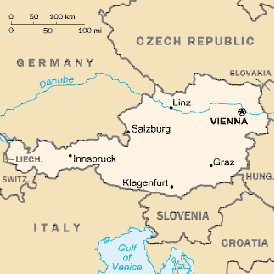 |
| Population (million): |
8.06 |
| Population per sq km: |
96.11 |
| |
|
| Capital: |
Vienna |
| Population of capital: (m) |
1.54 |
| Language: |
German |
| |
|
| Exchange rate: |
|
| - apot rate (24 August 2004) |
USD1 = EUR.81 |
| - annual average (2003) |
USD1 = EUR.89 |
| |
|
| GDP 2003 (USD billion): |
251.46 |
| GDP per capita 2003 (USD thousand): |
31.2 |
| Sources: Austrian Central Statistical
Office - Vienna, CIA, EIU, World Bank |
Political profile
Located on the key Danube trade route between eastern and western
Europe, Austria was a dominant political force under the Hapsburg dynasty
which ruled until the First World War. Following the conclusion of the War
in 1918, Austria became a federal republic until it was annexed by the
German Third Reich in 1938. Though liberated in 1945, it did not regain
its independence until 1955 when its State Treaty declared it a
'permanently neutral' country.
Austria is governed by the head of state - the president - while the
government is led by the chancellor. The national parliament is made up of
two houses: the Bundesrat (upper house), a 64-member assembly appointed by
the state parliaments, and the Nationalrat (lower house), a 183-strong
chamber elected for a four-year term by proportional representation, which
forms the national executive headed by the chancellor. Between October
1999 and late 2002 the country was governed by a coalition of the
Conservative People's Party (OVP) and the far right Freedom Party (FPO).
The inclusion of the FPO in the coalition sent shockwaves across Europe
and Austria's relations with the EU were severely strained after some
states imposed sanctions in protest. These were lifted some months later.
The OVP/FPO alliance broke down in September 2002 after three FPO members
resigned over the party's role in government. The chancellor, Wolfgang
Schuessel, called for an early general election in November, and the OVP,
led by Schuessel himself, made sweeping gains to win 42.3% of the vote.
The Social Democrats (SPO), which had come first in the previous election
of 1999, secured 36.9% of the vote while the FPO took 10.2% and the Green
Party 9%. Following the election, Schuessel held talks with the SPO and
the Green Party, but these broke down in February 2003 and, despite
initial reluctance, the OVP agreed to form another government with the FPO.
Turnout in Austria for the European Parliament elections on 13 June
2004 was fairly low by Austrian standards, at just over 40%. The SPO edged
out the OVP for first place, while support for the FPO again fell back
sharply.
Economic development
Austria is a member of the EU and a participant in economic and
monetary union (EMU). Vienna hosts a number of international organisations,
including the OSCE Secretariat, the International Atomic Energy Agency and
the Organisation of Petroleum Exporting Countries. Its economy has
traditionally been stable, although the past few years have seen growth
adversely affected by domestic political upheavals. GDP grew by just 0.8%
in 2003, down from 1.4% in 2002 but virtually unchanged from the 0.75%
recorded in 2001. Growth is forecast to recover to around 1.7% in 2004 and
2.4% in 2005, in line with the upturn in the wider European and global
economies.
Inflation is low, standing at 1.4% at the end of 2003, down from 1.8%
the previous year and 2.7% in 2001; despite a rise to around 2% in
mid-2004, it is expected to fall back below 1.5% by the end of the year.
Unemployment is also low by European standards, although it has risen
steadily from 3.6% in 2001 to 4.25% in 2002 and 4.35% in 2003. Throughout
2004 and 2005 the government is expected to continue with its challenging
programme of expenditure consolidation and tax-cutting measures.
|
Austria Regulatory Overview |
|
|
| |
Regulations
| Regulatory Bodies: |
Responsibilities: |
| KommAustria |
A division within the Federal Chancellery established in April
2001 to regulate both the broadcasting and telecoms markets. Has a
six-member board, appointed by the government for six years. |
| Independent Federal Communication Board |
Five-member tribunal charged with monitoring the activities of
KommAustria. Three members must be judges, one member is appointed by
the Supreme Court, two by the Court of Appeal and the remaining two by
government. |
| Regulatory Authority for Broadcasting and Telecommunications (RTR)
|
Administrative arm of KommAustria which is responsible for
granting broadcasting licences, supervising private broadcasters and
technical type-approval. It also supervises public service broadcaster
ORF and has assumed the duties previously assigned to the Private
Broadcasting Authority, the Commission for the Observance of the
Regional Radio Act and the Commission for the Observance of the Cable
and Satellite Broadcasting Act. |
| Press Council |
Voluntary organisation established in 1961 which monitors the
conduct and content of the Austrian press, including radio and TV
programmes. |
Key legislation
The primary laws governing the Austrian media landscape are The
Regional Radio Law (1993), The KommAustria Act [KOG] (2001) and The
Private TV Act [PrTV-G] (2001). No new laws specific to the media industry
have been introduced since, although in 2003 Austria adopted the
pan-European Electronic Communications Directive.
- The PrTV-G provides for the licensing of a single national
commercial terrestrial broadcaster and up to 49 local licensees.
- Cable operators have been allowed to produce their own programming
since August 1996. They do not have to obtain a licence but must
register with RTR. Satellite broadcasters, however, must obtain a
licence from the RTR prior to commencing operations.
- Since January 1997 publishing houses have been limited to a 26%
stake in radio stations; they may also own up to 10% in two further
stations. The amendment applies to both Austrian and foreign publishing
houses.
- Freedom of the press is guaranteed by the Federal Constitution. The
Media Law of 1982 provides additional protection for the privacy of the
individual and the professional freedom of the journalist. Subsidies are
awarded to all daily papers on request, as well as to a select few
weekly titles considered especially important for the general diversity
of opinion. This latter group must not devote more than 22% of their
annual volume of pages to advertising.
Channel provision and content
- Broadcasters must reserve at least 50% of the total transmission
time of each channel for works of European origin, and 10% of the total
transmission time for European works produced by independent producers.
- ORF’s obligation to show party political broadcasts was annulled in
2001.
Advertising
- ORF is permitted to include 42 minutes of advertising per day on its
TV channels. Product placement and theme sponsoring are prohibited.
- Advertising on Radio Ö1 is forbidden. Advertising on ORF’s local
radio stations is limited to five minutes per network, per day.
- The promotion of strong alcoholic drinks and tobacco is prohibited
and there is a blanket ban on advertising during children’s TV
programmes.
- Advertising on cable TV channels is restricted to 15% of airtime.
- Austria is the only country in Europe which levies an advertisement
tax on publishers
|
Austria Advertising Overview |
|
|
| |
Media advertising spend
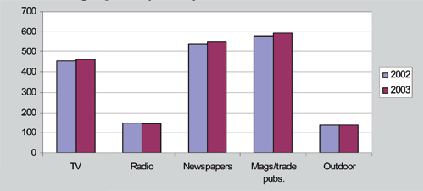
Source: Media Focus Research
Advertising trends
The Austrian advertising market has recovered from the stagnation it
experienced around the turn of the century, with modest growth returning
to the sector in 2003. According to FOCUS Media Research, total
expenditure reached EUR1.887 billion in 2003, a rise of almost 2% on the
previous year's tally of EUR1.852 billion. In contrast to most other
European countries, television is not the most popular medium with
advertisers, accounting for EUR463 million or just 24.5% of the total in
2003, compared to EUR455.5 million and 24.6% the year before. One trend
that has been developing in recent years is the growing share of adspend
commanded by the nation's commercial TV broadcasters. In 2003 the private
TV sector attracted EUR118 million of advertisers' money, a substantial
24% rise on the EUR94.9 million recorded in 2002, whilst during the same
time the amount spent advertising on the two national channels of public
service broadcaster ORF fell by 4.3% to EUR345.2 million.
The leading destination for adspend continues to be the printed press,
with daily newspapers attracting investments worth EUR549 million in 2003,
up from EUR537 million, and magazines and trade publications a further
EUR591 million (EUR577 million). The only medium to suffer a decline was
radio, where adspend fell fractionally from EUR146.8 million to EUR146
million. Of this, EUR101.5 million was allocated to ORF's stations (down
from EUR101.8 million), and EUR44.5 million to the growing band of
commercial radio broadcasters (EUR45 million). However, expenditure
figures for the first half of 2004 point towards a recovery for the radio
market, with investments over the six months reaching EUR89 million, a
rise of 10.3% over the corresponding period of 2003. Expenditure in all of
the other main segments also increased, with the trade periodical sector
witnessing the single highest proportional rise as investments grew by 13%
to EUR51.7 million (see table below).
A look at the list of leading Austrian advertisers by revenue makes for
familiar reading, with communications service providers Telekom Austria,
T-Mobile and tele.ring amongst the top ten. Other principal advertisers
include Spar, Unilever, Leiner Gruppe, Lutz Gruppe, BML Konzern and
Verlagsgruppe News.
Media advertising spend by sector, 1H 2003 vs 1H 2004 (EURm)
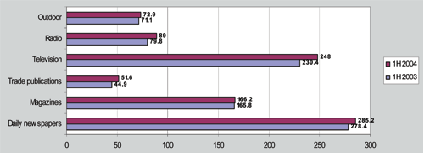
Source: FOCUS Media Research
|
Austria Media Update - Television |
|
|
| |
Market overview
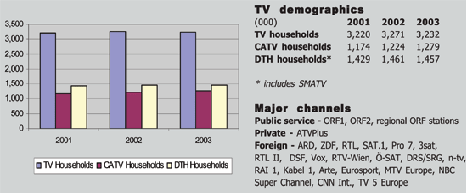
Source: ORF, RTR
Terrestrial television
The Austrian television landscape has changed considerably since the
implementation of the 2001 Private TV Law (PrTV-G) which saw public
service broadcaster ORF lose the monopoly it held in the terrestrial
broadcasting sector. In August 2001 the government invited applications
for the country's first commercial nationwide licence and, after assessing
five bids, finally awarded the concession to Vienna-based cable channel
ATV the following January. ATV targeted the third quarter of 2002 as its
prospective launch date but, after encountering delays in gaining
permission to use ORF's transmission facilities, was forced to postpone
its debut until 1 June 2003. At that date ATV changed its name to ATV+ and
began transmitting a mix of regional news and sports programming around
the clock. It has since incorporated a large percentage of light
entertainment and live Austrian football (in cooperation with satellite
service Premiere) into its schedule in a bid to heighten its appeal with
the youth and young adult audience and help it achieve a national market
share of 5% by the end of its first year. According to TELETEST, it failed
to reach this target, recording an audience rating of 1.2% in the second
half of 2003, rising to 1.8% in the first half of 2004. However, ATV+ has
long been a critic of TELETEST, saying it is biased in favour of its
parent company ORF. It claims its market share actually reached 4% between
January and June 2004, and said it plans to push for the establishment of
an independent body to collate TV viewer information. ATV+ is hoping to
achieve a 10% share of the national TV audience by the end of June 2005.
Contentious TV ratings aside, ATV+ has made considerable progress in
terms of increasing its coverage. Under its licenceconditions, ATV+ was
required to be accessible to at least 75% of the population either by
terrestrial means or via cable within twelve months. In March 2004 the RTR
announced that this stipulation had been met, with 78.4% of the population
able to receive ATV+ - 73.3% terrestrially and a further 5.1% via cable.
The station has also made solid progress on the advertising front,
securing revenues of EUR10.26 million in 2003, equal to 8.7% of the
national private TV adspend total, despite being on air for only half of
the year. ATV+ used to be owned by an alliance comprising pan-European
broadcasters SBS and UPC, and Germany's Tele Munchen and Austrian bank
Bawag. However, this has changed several times in the past year and as of
the end of August 2004 the station's owners were Ingebe Medien Holding
(41.48%), Concorde Media (36.86%), Athena Zweite (10%), Tele Munchen
(6.08%), Erste Bank (2.07%), Fundus (1.86%) and Generali Holding (1.65%).
At the same time as offering the nationwide licence, the RTR also
invited applications for 20 private regional and municipal licences. The
procedure ran on into the summer of 2002, when concessions were eventually
awarded to a number of companies in Vienna, Linz and Salzburg including
okal-TV, n-tv, Global Video Bernhard Graf, Kanal 1, Puls City TV,
Ganymedia Network, Smart.city.TV, RTV Regionalfernsehen, Lokal TV Austria,
Info TV Medien, Salzburg TV, Verein Freier Rundfunk Salzburg, Steiermark 1
TV, Bad Kleinkirchheim and LFT Lokalfernsehen Tirol.
Until the launch of ATV+, Austria was one of the only European
countries in which the public service broadcaster held a monopoly in the
terrestrial broadcasting sector. ORF transmits two national channels, ORF1
and ORF2, and nine local stations. It operates its own transmission
network comprising around 1,730 national transmitters and relay stations
and broadcasts mainly from Vienna, though it has local stations in each of
the country's nine broadcasting regions. ORF2 is the more popular of the
national offerings, recording a viewer share of 29.8% in the first half of
2004, the same as 2003. ORF1 achieved a rating of 21.9% in 2003, rising to
22.7% in the first half of 2004. In addition to its terrestrial line-up,
ORF transmits several TV and radio programmes via the Astra satellite to
around 230,000 Austrian households as part of German public service
broadcaster ZDF's digital bouquet. These include weather and tourism
channel TW1, ORF teletext and radio stations Ö1, Ö3, Blue Danube Radio,
FM4 and ROI. In 2003 ORF was financed mainly by a mix of licence fee
income (42%) and advertising (40%).
For the time being ORF's principal competition for viewers comes from
the raft of German commercial and public service channels which offer
'Austrian windows' and are delivered via cable or satellite to more than
two-thirds of Austria's TV households. The main channels falling into this
category are SAT.1, which recorded an Austrian viewing share of 5.7% in
the first half of 2004, RTL (5.4%), Pro 7 (4.7%), RTL2 (3%), Kabel 1
(2.8%) and Vox (2.8%). In January 2004 the RTL Group signed new longterm
contracts with Astra for the digital broadcast of its RTL Austria bouquet
comprising RTL, RTL 2, Super RTL and Vox.
Split of tv adspend
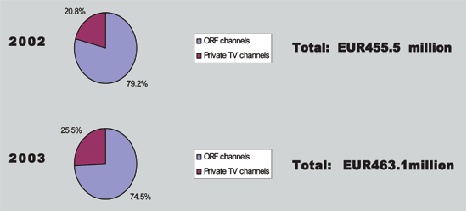
Source: FOCUS Media Research
Split of commercial tv adspend
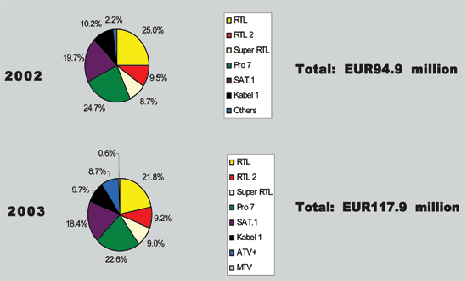
Source: FOCUS Media Research
Television viewing shares
All day, individuals 12+ 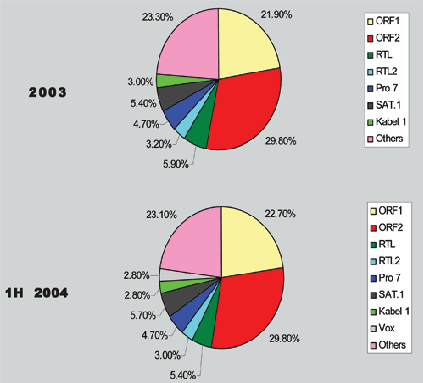
Source: TELETEST/Fessel-Gfk
Digital terrestrial television (DTT)
Austria launched limited trials of DTT services in Graz on 1 April
2004, in line with recommendations delivered in July 2003 by Digital
Platform Austria, a working group set up by the Federal Chancellery at the
start of 2002. The trials, which ended on 30 June, saw 150,000
participating households have access to an initial bouquet comprising just
three channels - ORF1, ORF2 and nationwide commercial channel ATV+ -
although 150 of the households also had at their disposal the opportunity
to test a wide variety of interactive services based on the multimedia
home platform (MHP). The services were offered via a fourth channel called
Kanal 4, which is being used as a platform for public and commercial
television broadcasters, set-top box manufacturers and software producers
to test a range of interactive and multimedia applications. Among these
were videoon- demand, home banking and e-mail. The Austrian advertising
industry was also involved, experimenting with interactive advertising
throughout the trial.
The return channel in the test households was provided by a several
methods, with around one third of the set-top boxes having an inbuilt
telephone modem, and the remainder using Fujitsu Siemens' ACTIVY Media
Box, containing an ADSL return channel. The RTR had initially hoped to
pilot a GPRS (general packet radio service) return channel as a third
method, but decoders supporting the technology were not available in time.
Although preliminary findings from the trials had still to be published by
mid-August, the government is known to be planning to extend trials to
other regions and to expand the bouquet of TV channels on offer to 16. A
public tender to build and operate the planned nationwide DTT
infrastructure is scheduled for the beginning of 2005. The RTR has
estimated that digitalisation of Austria's entire terrestrial transmission
network will be completed by 2012.
The burden of funding the DTT trials is being shared by ORF, ATV+,
local government authorities and the National Digitalisation Fund. The
last-named is a body established by the government in early 2003 into
which it has begun paying around 20% of the public TV and radio licence
fee, equating to around EUR10 million per year, to help pay for the
implementation of DTT. This has left many of the country's cable TV
players up in arms, not least because they do not receive any network
digitalisation subsidies themselves, and also because public funds will be
used to create a competing technical infrastructure. However, under-fire
Media Secretary Franz Morak has defended the government's plans, to which
he says it will remain committed, despite the vociferous opposition. Morak
is on record as saying that the funding of the DTT transmission network
can only be covered by the market to a certain extent, and that use of
public funds is an 'inevitable' consequence. The government has also moved
to answer criticisms that DTT services are not needed in a country with
such advanced digital cable TV and satellite TV platforms.
A report compiled by RTR in 2002 found that 63% of TV households were
still receiving at least some of their TV channels through a conventional
aerial - including the 1.45 million satellite homes. It claimed that this
represented a 'significantly different' situation from neighbouring
countries Germany and Switzerland where a large percentage of viewers rely
solely on DTH and cable networks with terrestrial reception playing only a
minor role.
Cable televison (CATV)
Despite the high penetration of satellite pay-TV services, Austria's
cable TV market continues to grow, with connections rising from 1.224
million to 1.28 million in 2003, according to figures from the RTR.
Although the market houses 260 operators, as in most European countries,
it is largely cornered by a handful of sizeable service providers. By far
the biggest of these is Telekabel, a 95% owned subsidiary of United
GlobalCom Europe, formerly United Pan-Europe Communications. Telekabel
operates five networks, in Vienna (the largest), Klagenfurt, Graz, Baden
and Wiener Neustadt; each network is 5% owned by the respective city
council. At the end of March 2004 Telekabel had passed 925,300 homes in
its service area, a rise of 2,000 over the year, from which it claimed
496,500 basic cable subscribers, down from 499,400 in mid-2003. As a
result of the slight decline, which the company attributed to a
combination of increased competition and stricter credit control measures
leading to the disconnection of a number of customers for non-payment of
bills, Telekabel's share of the market fell by around 2% to 38.8%.
The decline in analogue TV customers has been offset by the rising
popularity of its more expensive digital cable TV offering, which claimed
26,600 customers at the end of March 2004, up from 22,000 in June 2003.
Telekabel also offers internet and telephony services. The former were
launched on a narrowband basis in September 1997, with a broadband version
following in June 1999. By the end of March 2004 the company claimed
218,900 internet customers, up from 191,800 in mid-2003, all of which were
residential. Cable telephony services were launched in 1999 in Vienna and
have since been extended to Baden, Graz and Klagenfurt. By the start of
April 2004 the company reported 154,300 lines in service, up from 150,500
nine months previously. Telekabel also operates a joint fixed-mobile
package and a joint broadband internet-mobile package with mobile operator
Connect Austria.
Trailing Telekabel are a small band of mid-sized operators, each
boasting modest subscriber bases of between 50,000 and 100,000 and typical
basic packages of between 30 and 40 analogue channels. These include
LiWest-Kabelmedien, which operates a single network offering 40 TV and
over 30 radio programmes in and around the city of Linz. LiWest is the
country's second largest operator, despite the fact that its cable TV
subscriber base has remained static at around 100,000 for the past few
years. The company also offers internet and telephony, but does not
divulge customer numbers for these services. LiWest is owned by Energie AG
OÖ, ESG Linz and E-Werk Wels.
Of a similar size to LiWest is Salzburger Aktiengesellschaft für
Elektrizitäts (SAFE), the Salzburg electricity company which operates a
single network over which it offers CATV services and internet access. By
the end of 2003 it had just under 100,000 cable TV subscribers, and around
10,000 internet customers.
Other operators worth a mention are Eisenstadt-based Burgenländische
Kabel und Fernsehen (BKF), which serves around 65,000 subscribers with its
single network covering Eisenstadt and most of Burgenland; Kabelsignal, a
wholly owned subsidiary of energy company EVN, which served 60,000 TV and
18,000 internet customers with its networks in Lower Austria and Styria at
the end of 2003, up from 54,000 and 15,000 the year before; and Telesystem
Tirol, which offers a 'triple play' package of TV, internet and telephony
services, to which it had 50,000 customers at the end of 2003.
Telesystem's internet services are provided by UGC subsidiary chello,
whilst tele.ring supplies the telephony offering.
Swiss operator Cablecom also offers cable TV services in the Vorarlberg
region of western Austria, but does not release subscriber figures.
Evolution of pay-TV penetration (%)
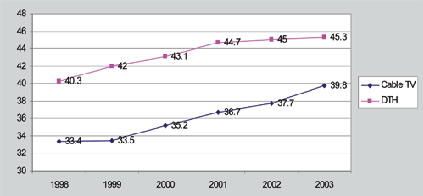
Source: RTR
Satellite direct-to-home (DTH)
According to the RTR, 1.457 million TV households were receiving their
TV services exclusively via the Astra 3A satellite platform at the end of
2003, a small decline from 1.461 million recorded twelve months
previously, but still up on the end-2001 total of 1.43 million. Whereas
most of the country's cable TV subscribers are found in and around Vienna
and the other main conurbations, the majority of DTH households are in
Carinthia and Lower Austria; indeed, the regulator has estimated that two
thirds of households in these areas receive their TV signals via
satellite.
The majority of DTH subscribers pay a modest monthly fee to receive a
bouquet of up to 40 analogue channels, including the Austrian terrestrial
line-up and a number of free-to-air stations from Germany, Italy and other
neighbouring countries. However, digital satellite services have become
more widespread recently, with by far the most popular offering being the
German platform Premiere World, which was launched in Austria as DF1 in
September 1996 but changed its name in the autumn of 1999 when DF1 merged
with Premiere. Formerly part of the ill-fated Kirch Media empire, Premiere
was purchased in February 2003 by German private equity house Permira,
which has since succeeded in reviving the broadcaster's fortunes. Under
the guidance of chief executive officer (and shareholder) Dr Georg Kofler,
in 2003 Premiere cut its operating loss to USD13 million on sales of
USD1.2 billion, having made a loss of USD424 million in 2002. The platform
has built its recovery on a contentious new strategy which, in addition to
the ever-popular live sports coverage, has included the introduction of
'adult' films in the programming schedule.
When he took over, Dr Kofler estimated that Premiere needed three
million subscribers to break even, and this was finally achieved in June
2004 when the company succeeded in adding 150,000 subscribers to its
end-2003 total of 2.85 million. Shortly after announcing the landmark, Dr
Kofler revealed that although he had no plans to leave Premiere, he was
already on the lookout for a new venture, leading to press speculation
that he is looking into the possibility of merging the platform with
commercial broadcaster ProSieben (Pro 7). As it stands Premiere is owned
by Permira (54.76%), Dr. Kofler (20.46%), Bayerische Landesbank and
HypoVereinsbank (10% each), Austria's BAWAG (3.5%) and Premiere management
board members Michael Börnicke and Hans Seger (0.64% each).
Subscriptions to Premiere Austria have also been gathering pace, thanks
mainly to a revamped line-up comprising mainly live Austrian football and
ice hockey, coverage of the UEFA Football Champions League and the German
Bundesliga, international movie blockbusters, Austrian film productions,
documentaries and children's programmes. At the end of 2003 Premiere
Austria had approximately 250,000 subscribers, up from 140,000 two years
previously.
|
Austria Media
Update - Radio |
|
|
| |
Market overview
| Major Stations |
| Public service: |
Ö1, Ö2, Ö3, FM4, ORF International |
| Commercial: |
Atenne Salzburg, Antenne Kärten, RPN Donauwelle, Life
Radio, Melody FM, Antenne Steiermark, Antenne Tirol, Antenne
Vorarlberg, 88.6 L!ve, Antenne Wien, Digi Hit Radio, Club Radio
Saltzburg, Music Radio, Radio Arabella, Radio Energi, Radio Maria,
Radio Max |
Austria’s radio market has been highly competitive since the
implementation of the Regional Radio Law of 1993 which opened both the
regional and local radio markets to private broadcasters. Despite the
plethora of players now present, ORF’s four stations retain a stranglehold
on the sector, with a market share of 82% in 2003; it should be noted,
however, that the body responsible for collating radio shares in Austria,
RADIOTEST, is itself a subsidiary of ORF.
ORF's radio offerings cover 98% of the territory via a network of 850
transmitters. The most popular of its stations is Ö3, which broadcasts
mainly pop music and news around the clock. According to RADIOTEST, Ö3 had
a national market share of 38% in 2003, up from 35% in 2002, an increase
which saw it knock erstwhile market leader Ö2 off the top of the ratings
pile. The latter transmits mainly regional news and folk music to the
'over 35s' and recorded a national listener share of 37% in 2003, a fall
of one percentage point over the year. ORF's other channels are far less
popular: Ö1 broadcasts a mix of music, arts, literature and science
programmes and recorded a market share of 5% in 2003 (unchanged); FM4
transmits a multilingual programme of news and entertainment round the
clock and had a 2% share (also unchanged); and finally Radio Österreich
International (ROI) is a shortwave service for Austrians living abroad.
ORF also operates a network of nine regional radio stations.
The country's commercial radio operators and overseas or 'window'
stations are fighting an uphill battle to tempt listeners away from ORF's
bouquet. Collectively the 65 private operators now broadcasting accounted
for just 16% of the national radio audience in 2003, down from 20% in
2002. Half the problem is limited reach; whereas ORF utilises a vast
transmitter network, the private sector is served by just 150, with the
biggest players having a maximum of 16 transmission sites at their
disposal; most have just one or two. In terms of both reach and
popularity, the main commercial player is the Antenna radio group, which
has operations in most Austrian provinces including Styria, Carinthia,
Vorarlberg and Tyrol, in addition to main cities such as Salzburg and
Vienna. Other popular commercial stations outside the Antenna Group,
including Kronheit, 88.6 Live!, Radio Arabella, Energi 104.2, Radio
Stephansdom and 106.7 Party FM. Two commercial stations transmit via
satellite only - Radio Maria and Radio Max, and the most popular of the
window stations is Hit FM.
Split of radio adspend
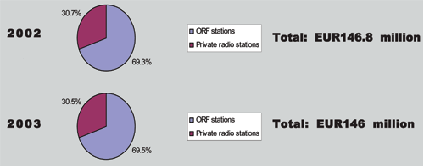
Source: FOCUS Media Research
Radio market shares, 2003
All day, individuals 12+
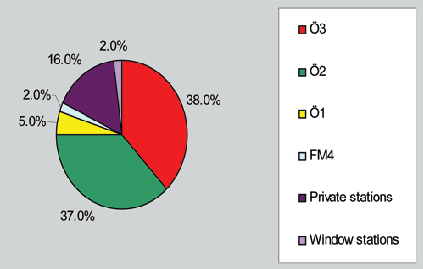
Source: RADIOTEST
|
Austria Media Update - Newspapers |
|
|
| |
Market overview
A daily newspaper is a must for many Austrians with more than three
million copies distributed daily by Austria Post to a population of just
eight million. This makes the printed press a highly desirable channel for
advertisers, with newspapers and magazines attracting EUR1.14 billion
worth of investments in 2003, 60% of the national yearly media adspend, up
from EUR1.11 billion in 2002 (also 60%).
The printed press has been subsidised since 1975 when the government,
faced with rising concern over difficulties faced by small publishers,
introduced a system to financially support newspapers and magazines
meeting certain criteria. As a general rule, small subsidies go to all
regional daily papers at their request, with larger sums going to a few
other papers considered especially important to the diversity of opinion.
For a regional daily newspaper to receive funding, it must have a minimum
circulation of 10,000, the figure falling to 5,000 for regional weekly
titles. Magazines are eligible for funds if they publish between four and
forty issues a year. The amount each title is allocated is decided on a
case-by-case basis, but no single newspaper can receive more than 5% of
the total subsidy budget.
Following several bouts of consolidation in the 1990s, the national
daily newspaper market has been whittled down to 15 titles by the end of
2003, just over half the number present some forty years earlier. The
market is dominated by Mediaprint, a joint venture between its founder
Hans Dichand and the German publishing group Westdeutsche Allgemeine
Zeitung (WAZ), which has the two biggest titles under its control - Neue
Kronen Zeitung and Kurier. These two account for more than a third of
daily circulations in Austria. According to the ÖAK, Austria's circulation
control agency, in the first three months of 2004 Neue Kronen Zeitung
recorded a circulation of 859,000, up from 849,000 in 2003, almost five
times as many copies as Kurier, which ended March 2004 with average sales
of 173,000, a rise of 1,000 on its 2003 returns.
The third best-selling daily, Die Presse (76,000), is owned by another
of Austria's newspaper heavyweights, Styria Media, a company whose real
strength lies in the regional newspaper market where it is responsible for
three of the five leading titles - Kleine Zeitung (262,000), Kleine
Zeitung Graz (172,000) and Kleine Zeitung Klagenfurt (89,000).
Top papers by circulation
| Title |
Circulation (000)
|
Publisher |
Frequency |
| |
1Q 2004
|
2003
|
|
| National dailies |
| Neue Kronen Zeitung |
859
|
849
|
Mediaprint Zeitungsverlag |
Daily |
| Kurier |
173
|
172
|
Mediaprint Zeitungsverlag |
Daily |
| Die Presse |
76
|
77
|
Styria |
Daily |
| Der Standard |
66
|
67
|
Oscar Bronner |
Daily |
| Wirtschafts Blatt |
29
|
34
|
Radda & Dressler |
5 x week |
| Regional dailies |
| Kleine Zeitung |
262
|
258
|
Styria Media |
Daily |
| Kleine Zeitung Graz |
172
|
170
|
Styria Media |
Daily |
| OÖ Nachrichten |
106
|
104
|
Wimmer Median |
Daily |
| Tiroler Tageszeitung |
93
|
92
|
Schlüsselverlag |
Daily |
| Kleine Zeitung Klagenfurt |
89
|
88
|
Styria Media |
Daily |
| Salzburger Nachrichten |
70
|
75
|
Salzburger Nachrichten |
Daily |
| Vorarlberger Nachrichten |
66
|
66
|
Vorarlberger Zeitungsverlag |
Daily |
Source: ÖAK
Split of printed press adspend
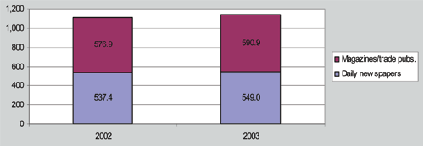
Source: FOCUS Media Research
|
Austria Media Update - Magazines |
|
|
| |
Market overview
Austria's magazine market is dominated by German companies. The largest
publisher by some margin, News Group, is owned by German publisher Gruner+Jahr
(56.03%) and Kurier Magazine Verlags (25.3%); the former is a subsidiary
of German media giant Bertelsmann, whilst the latter is 49.4% owned by WAZ.
The remaining 18.67% of News Group is held by founders Wolfgang and
Hellmut Fellner.
The most popular of News Group’s 15-strong portfolio of titles is the
television guide TV Media, the leader in its segment with an average
weekly circulation of 253,000 in the first half of 2004, down slightly on
2003 levels. Next best is general interest magazine News, which had a
circulation of 252,000 in the first half of 2004, down marginally from
254,000 in 2003. News is the second most popular general interest magazine
in Austria, and despite being well clear of the third-placed title,
Wienerin (48,000), it nevertheless trails the segment leader Die Ganze
Woche, published by Familiapress, by a sizeable margin; the lastnamed
title recorded an average weekly circulation of 349,000 in the first
quarter of 2004, up 7,000 on 2003.
News Group has a firm grip on the business magazine market with three
of the leading four titles under its control - the weeklies Profil
(78,000) Format (61,000) and and the monthly title Trend (62,000). News
Group also presides over the leading titles in the women’s and special
interest magazine markets, Woman (199,000) and e-media (130,000). In early
2004 the company launched a new health magazine, News Leben, and a new
'teenage' title, Young Style, both published quarterly.
| Title |
Circulation (000)
|
Publisher |
Frequency |
| |
1Q 2004
|
2003
|
|
| General interest / family |
| Die Ganze Woche |
349
|
342
|
Familiapress |
Weekly |
| News |
252*
|
254
|
News Group |
Weekly |
| Wienerin |
48
|
51
|
Metro Holdings |
Monthly |
| Medizin Populär |
38
|
39
|
Öst. Artzekammer |
Monthly |
| Wiener |
34
|
34
|
Metro Holdings |
10 x year |
| Business / economics / politics |
| Profil |
78
|
76
|
News Group |
Weekly |
| Gewinn |
62
|
65
|
Wailand & Waldstein |
Monthly |
| Trend |
62*
|
68
|
News Group |
Monthly |
| Format |
61*
|
68
|
News Group |
Weekly |
| Television guides |
| TV Media |
253*
|
255
|
News Group |
Weekly |
| Women / fashion |
| Woman |
199*
|
192
|
News Group |
Fortnightly |
| Wellness Magazin |
130
|
127
|
Zeitschriftenverlags |
Monthly |
| Welt der Frau |
56
|
58
|
Kath. Frauenwerk |
Monthly |
| Special interest |
| e-media |
130*
|
138
|
News Group |
Fortnightly |
| Alles Auto |
61
|
57
|
Hannover International |
Monthly |
| Gusto |
53*
|
52
|
News Group |
Monthly |
| Autorevue |
53*
|
54
|
News Group |
Monthly |
| Sportmagazin |
40
|
26
|
Verlag Sportmagazin |
Monthly |
Source: ÖAK
* figures for News Group titles are 1H 2004
|
Austria Media Update - Wireless |
|
|
| |
Main wireless operators
| Operator (main shareholder) |
Network
|
Evolution
|
Launch Date
|
Subscribers
|
% change
|
% pre-paid
|
| |
End
2002
|
March 2004
|
|
|
| Mobilkom (Telekom Austria, 100%)
|
GSM-900/1800
|
GPRS
|
1990
|
3,001
|
3,170
|
5.6%
|
47%
|
|
WCDMA
|
-
|
2002
|
na
|
na
|
-
|
-
|
| T-Mobile (T-Mobile International, 100%) |
GSM-900/1800
|
GPRS
|
1996
|
2,048
|
2,012
|
-1.8%
|
55%
|
| Connect Austria (E.ON, 50.1%) |
GSM-1800
|
GPRS
|
1998
|
1,398
|
1,500
|
7.3%
|
40%
|
|
WCDMA
|
-
|
2003
|
na
|
na
|
-
|
-
|
| tele.ring (Western Wireless, 100%) |
GSM-1800
|
GPRS/EDGE
|
2000
|
276315
|
726
|
131%
|
21%
|
| Hutchison 3G Austria (Hutchison Whampoa, 100%) |
WCDMA
|
-
|
2003
|
-
|
-
|
-
|
-
|
| Total number of mobile subscribers: |
6,762,400
|
7,434,400
|
|
| Cellular penetration: |
84%
|
92.4%
|
|
Major recent technology/content deals
July 2004
- T-Mobile signs deal with Macromedia under which the Macromedia Flash
Lite 1.1 Media Player will power News Express, T-Mobile's new mobile
multimedia news service initially being launched in the UK, Germany and
Austria.
June 2004
- Mobilkom launches the Vodafone Live! service with subscribers able
to pay EUR5 a month for access to the Vodafone Live! portal and five MMS
messages.
May 2004
- Mobilkom installs WLAN wireless internet access hot-spots in the
Trend chain of hotels (Austria's largest).
April 2004
- Mobilkom awards Ericsson a contract to supply radio base stations
for the expansion of its UMTS network through until 2007. The frame
agreement includes a customer support contract and Ericsson is also to
provide guaranteed service levels to secure network performance
regarding hardware and software functionality. Ericsson will provide
access to software updates through its software base subscription
service.
- Connect Austria awards a EUR160 million contract to Ericsson for the
delivery and installation of base stations and supplementary equipment
for its UMTS network. Ericsson will provide all hardware and software,
as well as equipment for network access control.
- Mobilkom launches the A1 Music Zone, allowing subscribers to access
music, news, ringtones and MP3s. The application was developed in
conjunction with Vienna-based content provider Super-Fi.
February 2004
- Connect Austria launches m-commerce services following successful
trials using a payment platform developed by Trivnet. Customers are able
to charge online purchases to their mobile phone bill or have them
deducted from their prepay credit without having to pre-register or
install further software. Among the first companies to sign up to the
service are Coca Cola and ticketing service Österreich Ticket.
- Mobilkom begins streaming 24-hour news channel CNN International
Live to its 3G mobile subscribers.
- Mobilkom launched the Vodafone Mobile Connect UMTS/GPRS datacard,
offering corporate customers mobile access to e-mail, internet and
company data at download speeds of up to 384kbps.
January 2004
- Mobilkom acquires the UMTS licence awarded to Telefónica subsidiary
3G Mobile Telecommunications (3G Mobile), giving it the right to use 3G
Mobile’s two UMTS frequency blocks amounting to 9.8MHz, taking its total
to 19.8MHz over four blocks. The deal carries a condition that Mobilkom
must sell one of its four frequency blocks by 31 January 2005.
October 2003
- Mobilkom launches A1 PUSH MAIL to the ISP community. Using the new
service ISPs can forward email to their customers' mobile phones.
July 2003
- T-Mobile introduces a new MMS offering allowing users to send short
video clips.
May 2003
- T-Mobile extends its SMS service, enabling customers to send
messages to up to five people at the same time.
April 2003
- Mobilkom becomes the first Austrian cellco to launch 3G services on
a commercial basis, offering a raft of applications including video
streaming at speeds of up to 384kbps.
February 2003
- Connect Austria introduces a new service allowing customers to send
MMS to T-Mobile customers, and vice-versa; previously MMS messages could
only be sent between Connect subscribers.
November 2002
- Mobilkom forms a new subsidiary, A1 Bank, to handle its secure
m-commerce transactional duties.
Sepember 2002
August 2002
- Mobilkom enables GPRS roaming facilities.
July 2002
- Mobilkom launches A1 SMS TICKET, a fully electronic mobile ticketing
system, in conjunction with Austria Ticket and m-commerce service
provider Connovation.
Regulatory & professional bodies
Association of Audiovisual & Film Industry
Wiedner Hauptstrasse 63
A-1040 Vienna
Austria
Tel: 43 1 50105
Fax: 43 1 50206276
Dr Bater-Lunger, Managing Director
Austrian Newspaper Association (VOZ)
Renngasse 12
A-1010 Vienna
Austria
Tel: 43 1 5337979
Fax: 43 1 533797922
Dr Walter Schaffelhofer, Secretary General
www.voez.at
Austrian Press Agency (APA)
Gunoldstrasse 14
A-1199 Vienna
Austria
Tel: 43 1 36060
Fax: 43 1 360603099
Dr Wolfgang Vyslozil, Managing Director
www.apa.at
Fachverband der Telekommunikations- und Rundfunkunternehmungen
Berufsgruppe Kabel-TV
Wiedner Haupstrasse 63
A-1045 Vienna
Austria
Tel: 43 1 501053170
Fax: 43 1 50105283
Federal Chancellery
Ballhausplatz 2
A-1014 Vienna
Austria
Tel: 43 1 531150
Fax: 43 1 5350338
Franz Morak, Secretary of State for Art and Media
www.bka.gov.at
Medien und Recht
Danhausergasse 6
A-1040 Vienna
Austria
Tel: 43 1 5052766
Fax: 43 1 5052766
Dr Heinz Wittman, Director
www.medien-recht.com
ÖAK - Österreichische Auflagenkontrolle
Kollnerhoffgasse 2/3
A-1010 Vienna
Austria
Tel: 43 1 533617812
Fax: 43 1 533617822
Rudolf Wolfbauer, President
www.oeak.at
ORF Markt und Mediaforschung
Wurzburggasse 30
A-1136 Vienna
Austria
Tel: 43 1 8787813678
Fax: 43 1 8787812743
Dr Monica Linder, Managing Director
www.orf.at
ORF Radioforschung HPF
Argentinierstrasse 30
A-1040 Vienna
Austria
Tel: 43 1 5010118075
Fax: 5010118078
ÖZV - Österreichischer Zeitschriften Verband
Renngasse 12-16
A-1010 Vienna
Austria
Tel: 43 1 3197001
Fax: 43 1 3197001
Dr Rudolf Bohmann, President
www.oezv.at
Public Relations Verband Austria
Lothringerstrasse 14, 2nd floor
A-1030 Vienna
Austria
Tel: 43 1 7151540
Fax: 43 1 7151535
Christian Kollman, President
Verband Druck und Medientechnik (Printers Association)
Grünangergasse 4
A-1010 Vienna
Austria
Tel: 43 1 5126609
Fax: 43 1 513282619
Dr Hans Inmann, Director
www.druckundmedientechnik.or.at
Broadcasters & TV channels
88.6 L!ve Radio Eins
Heiligenstädter Lände 29
A-1190 Vienna
Austria
Tel: 43 1 360880
Fax: 43 1 366088109
Stephan Schwenk, Director
Antenne Salzburg
Am Messezentrum
A-5020 Salzburg
Austria
Tel: 43 662 40800
Fax: 43 662 408070
Peter Don, Managing Director
www.antenne-salzburg.at
Antenne Tirol
Eduard Boden Gasse 6
A-6020 Innsbruck
Austria
Tel: 43 512 244220
Fax: 43 512 24422550
Matthias Nieswandt, Managing Director
www.antenne.at
Antenne Wien
Storchengasse 1
A-1150 Vienna
Austria
Tel: 43 1 21700
Fax: 43 1 21700139
Ronald de Martin, Sales Director
www.antenne-wien.at
Austria Television (ATV)
Aspenbruckengasse 2
A-1020 Vienna
Austria
Tel: 43 1 213640
Fax: 43 1 213647979
Tillmann Fuchs, Managing Director
KTV
Baumlegasse 35
A-6850 Dornbin
Austria
Tel: 43 5572 56510
Fax: 43 5572 56510
Mr Knoer, Director
Life Radio
Landstrasse 12
A-4020 Linz
Austria
Tel: 43 732 76070
Fax: 43 732 76070
Christian Stagmuller, Managing Director
www.liferadio.at
ORF - Österreichischer Rundfunk
Wurzburggasse 30
A-1136 Vienna
Austria
Tel: 43 1 878780
Fax: 43 1 878783792
Franz Manola, Director General
Panorama TV
Feratel International
Lanbichl 60
A-5452 Pfarrwerfen
Austria
Tel: 43 6468 89101
Fax: 43 6468 8901674
www.feratel.at
TW1
Moostrasse 105a
A-5020 Salzburg
Austria
Tel: 43 662 827766
Fax: 43 662 8277666
Manuela Strihavka, Programme Director
www.tw1.at
Cable operators
BKF-Burgenlandisches Kabelfernsehen
Zentrale Eisenstadt
Neusiedler Strasse 86
A-7000 Eisenstadt
Austria
Tel: 43 2682 90030
Fax: 43 2682 9003116
Christian Kurtz, Managing Director
Kabelsignal
Sudstadt-Zentrum 1/30
A-2344 Maria Enzerdorf
Austria
Tel: 43 2236 455640
Fax: 43 2236 4556779
Mr Bammer, President
LiWest Kabelmedien
Lindengasse 18
A-4040 Linz Urfahr
Austria
Tel: 43 732 9424
Fax: 43 732 942480
Guenther Singer, Managing Director
Salzburger AG fur Energiewirtschaft (SAFE)
Bayerhamerstrasse 16
A-5020 Salzburg
Austria
Tel: 43 662 88840
Fax: 43 662 8884170
Dr Franz Schausberger, Chairman
Telekabel Wien
Erlachgasse 116
A-1100 Vienna
Austria
Tel: 43 1 960600
Fax: 43 1 96060606
Tomas Hintze, Managing Director
Telesystem Tirol
E-Boderngasse 2
A-6020 Innsbruck
Austria
Tel: 43 512 33999
Fax: 43 512 3399950
Walter Hold, Managing Director
Major publishers
ARBO
Argentinierstrasse 2
A-1040 Vienna
Austria
Tel: 43 1 50309090
Fax: 43 1 5090999
Johannes Thun-Hohenstein, Managing Director
Gruner+Jahr
Parkring 12
A-1011 Vienna
Austria
Tel: 43 1 512881030
Fax: 43 1 512564716
Luthwig W. Erwin, Managing Director
www.guj.de
Mediaprint
Muthgasse 2
A-1191 Vienna
Austria
Tel: 43 1 360000
Fax: 43 1 360003942
Wolfgang Altermann, Managing Director
Radda & Dressler Verlag
Davidsgasse 79
A-1100 Vienna
Austria
Tel: 43 1 60117249
Fax: 43 1 60117240
Monika Athanasiadis, Managing Director
Styria Medien
Schonaugasse 64
A-8010 Graz
Austria
Tel: 43 316 80631001
Fax: 43 316 80631004
Ingrid Sohar, Marketing Manager
www.styria.com
Verlagsgruppe News
Taborstrasse 1-3
A-1020 Vienna
Austria
Tel: 43 1 213120
Fax: 43 1 21312160
Helmuth Fellner, Managing Director
www.news.at
Newspapers & magazines
Das Beste - Reader's Digest
Verlag Das Beste
Singerstrasse 2
A-1010 Vienna
Austria
Tel: 43 1 5132554
Fax: 43 1 5139752
Gerhard Faisst, Managing Director
Die Ganze Woche
Familiapress
Ignaz-Köck Strasse 17
A-1211 Vienna
Austria
Tel: 43 1 291600
Fax: 43 1 459199014
Kurt Falk, Editor
GewinnWailand & Waldstein GmbH
Stiftgasse 31
A-1070 Vienna
Austria
Tel: 43 1 521240
Fax: 43 1 5212440
Dr Georg Wailand, Editor
Kleine Zeitung
Schönaugasse 64
A-8011 Graz
Austria
Tel: 43 316 873700
Fax: 43 316 875701
Kurt Wimmer, Editor
Kronen Zeitung
Mediaprint
Muthgasse 2
A-1191 Vienna
Austria
Tel: 43 1 36000
Fax: 43 1 360003942
Hans Dichand, Editor
Kurier
Mediaprint
Lindengasse 48-52
A-1070 Vienna
Austria
Tel: 43 1 521000
Fax: 43 1 52100
Richard Kaufman, Managing Director
Neuen Vorarlberger
Kercrestrasse 35
A-6090 Bregenz
Austria
Tel: 43 557 4409
Fax: 43 557 4409300
Norbert Freuz, Editor
Niederösterreichische Nachrichten (NÖN)
Niederösterreichisches Pressehaus
Gutenbergstrasse 12
A-3100 St Pölten
Austria
Tel: 43 2742 8021381
Fax: 43 2742 9021480
Harald Knabl, Editor
Oberösterreichische Nachrichten
Wimmer Media
Promenade 23
A-4010 Linz
Austria
Tel: 43 732 7805210
Fax: 43 732 783479
Dr Hans Köppl, Editor
Oberösterreichische Rundschau
Hafenstrasse 1-3
A-4010 Linz
Austria
Tel: 43 732 76160
Fax: 43 732 7616302
Rudolf Chelir, Editor
Die Presse
Die Presse Verlags GmbH
Parkring 12A
A-1015 Vienna
Austria
Tel: 43 1 514140
Fax: 43 1 51414251
Andreas Underberger, Editor
Salzburger Nachrichten
Salzburger Nachrichten Verlags
Karolingerstrasse 40
A-5021 Salzburg
Austria
Tel: 43 662 83730
Fax: 43 662 8373399
Ronald Barazon, Editor-in-Chief
www.salzburg.com
Der Standard
Herrengasse 19-21
A-1014 Vienna
Austria
Tel: 43 1 53170
Fax: 43 1 53170249/264
Oscar Bronner, Editor
Tiroler Tageszeitung
Schlusselverlag J. S. Moser
Ing-Etzel-Strasse 30
A-6021 Innsbruck
Austria
Tel: 43 512 53540
Fax: 43 512 575924
www.tirol.com
Claus Reitan, Editor
Trend
Lindengasse 52
A-1070 Vienna
Austria
Tel: 43 1 53470
Fax: 43 1 5347061
Thomas Martinek, Editor
Wirtschafts Blatt
Radda & Dressler
Davidgasse 79
A-1100 Vienna
Austria
Tel: 43 1 601170
Fax: 43 1 602858
Christian Radda, Editor
Wireless operators
Connect Austria (ONE)
Brünner Strasse 52
A-1210 Vienna
Austria
Tel: 43 1 277280
Fax: 43 6 9970770
Jorgen Bang-Jensen, Chief Executive Officer
www.one.at
Mobilkom
Obere Donaustrasse 29
A-1020 Vienna
Austria
Tel: 43 1 331610
Fax: 43 1 331613316
Boris Nemsic, Managing Director
www.mobilkomaustria.com
T-Mobile
Postfach 676
A-1031 Vienna
Austria
Tel: 43 1 06762000
Fax: 43 1 06762300
Dr Georg Polzl, Chairman
www.t-mobile.at
tele.ring
Hainburger Strasse 33
A-1030 Vienna
Austria
Tel: 43 1 9310120
Fax: 43 1 9310128015
Hubertus Hofkirchner, Chief Executive Officer
www.telering.at
Last updated: August 2004
Вернуться к списку
стран
|











